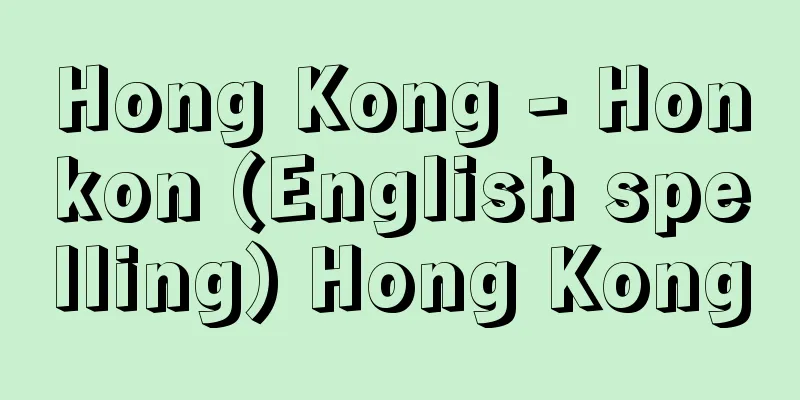Hong Kong - Honkon (English spelling) Hong Kong

|
A former British direct colony on the South China Sea coast in southern China. Since 1997, it has been the Hong Kong Special Administrative Region of China. Located 130 km southeast of Guangzhou, it consists of Hong Kong Island, the Kowloon Peninsula across the shore, and over 230 surrounding islands of various sizes. Hong Kong Island and its associated islands, as well as Kowloon and Stonecutters Island at the tip of the peninsula, were British direct territories. The rest of the peninsula and the other islands were called the New Territories, and were leased by Britain from China for 99 years from 1889 to 1997. Following the Sino-British Joint Declaration of December 1984, the entire territory of Hong Kong was returned to China on July 1, 1997. During the colonial period, it was ruled by a Governor-General, who represented the Queen of England, and was called the British Crown Colony. After the handover, it was ruled by the Chief Executive of the Special Administrative Region. The first Chief Executive was Tung Chee-hwa. The area is 1,106 square kilometers, and the population is 7,409,800 (2017). The population density is 6,780 people per square kilometer. The administrative center is in the Central and Western District of Hong Kong Island. [Shoichi Yokoyama] NatureHong Kong, which consists of a peninsula and numerous islands, has a coastline with many inlets and outlets, and good natural harbors in many places. However, because the plateau is close to the coast, there is little lowland, and only a small alluvial plain can be seen in the northern New Territories. The ground is mostly made up of granite and other volcanic rocks, and land use is severely restricted. 48% of the total area is grassland and brush, 20% is forest, 16% is residential and commercial/industrial land, and only 8% is cultivated land in the northern New Territories. High-rise buildings stand in a forest around Kowloon and on Hong Kong Island, and on Hong Kong Island they are densely packed up on the mountainside of Victoria Peak (554 meters), but this is due to the concentration of population in a small area and the hard ground. There are no large rivers, only a few in the northern New Territories. This causes a serious water shortage, and although there are many reservoirs, water is supplied (purchased) from mainland China. Hong Kong's area has increased by approximately 40 square kilometers since 1960, due to coastal reclamation on Hong Kong Island and Kowloon, which is used for commercial, port and residential purposes. The climate is subtropical monsoonal, as the country is located just south of the Tropic of Cancer and faces the South China Sea. In summer, the average temperature in July is 28.8°C, with southwesterly winds blowing, and it is rainy and humid. In winter, the average temperature in January is more bearable at 16.3°C, and the northeasterly winds make for a dry season. The country receives 2,398.5 mm of precipitation per year, but most of this falls during the rainy season around June and the typhoon season in August. [Shoichi Yokoyama] historyBritain's possession of Hong Kong began with the acquisition of Hong Kong Island by the Treaty of Nanking as a result of the Opium Wars (1840-1842). At the time, Guangzhou was the base for trade with China, but Hong Kong Island was a safe and good anchorage, and was close to the Chinese mainland, making it an alternative to Guangzhou. In 1842, Hong Kong was declared a free trade port early on, which later played a role in suppressing trade activities in Guangzhou. Britain then launched the Arrow War (1856-1860), and acquired Kowloon and Stonecutters Island by the Treaty of Peking, incorporating them into the British Crown Colony. In 1898, Britain leased the New Territories under the pretext of defending the Crown Colony, and this established the territory of Hong Kong as it is today. In 1899, Britain obtained the right to build the Kowloon-Canton Railway (Kowloon-Guangzhou) from China, and opened a coastal shipping route. Since then, Hong Kong has become Britain's base for trade, transportation, and finance with China and Asia. During the civil war following the founding of the Republic of China in 1912, Hong Kong became a refuge for Chinese people and their capital, but the intensification of nationalist movements led to a rise in anti-British protests between 1925 and 1927. However, as Japan came to control the northeastern region of China, relations between China and Britain became friendly, and when the Japanese army invaded China in 1937, a succession of Chinese people flowed into Hong Kong. However, with the outbreak of the Pacific War in 1941, Hong Kong was attacked by the Japanese army, and it remained under their occupation until August 30, 1945. After the Second World War, Hong Kong returned to British administration, and the Chinese Civil War from 1948 to 1950 and the establishment of the Communist regime led to a rapid increase in Chinese immigrants, especially refugees, and the population has continued to grow ever since. Until the 1950s, the economy relied on transit trade, but since the 1960s, industry and tourism have grown remarkably. During China's "Cultural Revolution," there were anti-British protests by left-wing Chinese in Hong Kong. However, China saw it as a good idea to take advantage of Hong Kong's importance in economic activities, politics, and diplomacy. With the shift to the "Reform and Opening Up" system under Deng Xiaoping at the end of 1978, China pursued negotiations with Britain with the strategies of "one country, two systems" and "Hong Kong people governing Hong Kong" as a path to the peaceful return of Hong Kong. On the other hand, in the 1980s, China established a special economic zone in Shenzhen, adjacent to Hong Kong, to attract active investment from Hong Kong and encourage overseas Chinese to visit China. [Shoichi Yokoyama] PoliticsSino-British negotiations began in September 1982, before the lease of the New Territories was due to expire. China proposed to maintain the status quo even after the handover, while Britain agreed to return sovereignty over all of Hong Kong to China in one go. The "one country, two systems" policy allowed Hong Kong to remain a special administrative region, with autonomy except for foreign affairs and national defense, and Hong Kong would maintain its current social and economic systems and status as a free trade port for 50 years. After the handover, the official name became "Chinese Hong Kong," and free elections were touted for the selection of the Chief Executive of the Special Administrative Region (Chief Executive of Hong Kong) and Legislative Council members under the "Hong Kong People Governance" system. However, the selection of these candidates was heavily influenced by the Beijing government, and some residents feared that Hong Kong would become more like China. [Shoichi Yokoyama] Industry and EconomyThe British acquired Hong Kong because they wanted to secure a military base in East Asia and to benefit from transit trade between the vast China and third countries. The city has prospered thanks to the freedom of commerce, trade, and financial activities based on a free trade port. After World War II, industrialization, mainly in light industries such as textiles, clothing, and plastic products, progressed due to Chinese capital and manufacturing industries fleeing from the Chinese Communist Party government, and the influx of many refugees. With capital investment from Japan and the United States, Hong Kong experienced rapid growth and developed into one of the leading processing trades in Asia. In the 1980s, assembly industries such as electrical equipment and computers became more common, but on the other hand, due to China's reform and opening-up policy, trade, finance, and commercial service industries became active in Hong Kong due to Chinese capital investment and industrialization in mainland China, and the economy underwent structural change. As of 2017, the proportion of manufacturing to the total number of employees was 2.5%, retail and trade were 8.3% and 12.8%, respectively, and finance and insurance were 6.8%. Hong Kong Chinese capital is actively investing in China, and with low labor wages they are building large factories and increasingly moving into urban development. Hong Kong is one of the world's leading trading destinations. In 1995, Hong Kong was ranked 9th in exports and 7th in imports, with a per capita trade value of $30,000, second only to Singapore, and in 2016 it was ranked 7th in exports and 7th in imports. Electrical equipment and parts, and communications and audio equipment account for half of Hong Kong's exports and imports, and re-exports account for 98.9% of exports (2017). Hong Kong's transit trade function is a tradition dating back to the British colonial period, but since the 1990s, the number of Chinese capital entering China has increased, and processed products originating from China have been actively exported via Hong Kong. China is by far the largest trading partner for both exports and imports. The development of trading functions has made Hong Kong a global financial center. Hong Kong in East Asia is favored by its geographical location halfway between New York and London, and its strong ties with overseas Chinese networks, mainly in Southeast Asia, which have led to active financial activity. Since the late 1980s, Hong Kong has become a regional center for business activities in Asia, with 1,530 foreign companies (companies with regional headquarters) based there (2018). Most of them are American and Japanese. Hong Kong is the most developed port city in Asia in terms of transportation, with 19.58 million containers (20-foot equivalent) handled in 2016, making it the sixth largest port in the world. It is also a crossroads in Asia on air routes, with airlines such as Cathay Pacific and Cathay Dragon. Kai Tak Airport was one of the largest airports in Asia, with over 25 million annual passengers, but as it reached its limit of use, Hong Kong International Airport was built on Lantau Island, west of Hong Kong Island, and the new airport was connected to the city center by rail and expressway. As a result, Kai Tak Airport was closed. To get to mainland China, there is the Guangzhou-Kowloon direct train that runs from Kowloon to Guangzhou via Shenzhen, the Guangzhou-Shenzhen-Hong Kong express rail line, and the expressway, and if you use the expressway, you can reach Guangzhou in two hours. [Shoichi Yokoyama] society97% of the residents are Chinese, of which about 60% were born in Hong Kong and are called Hongkongese. The majority of Chinese are of Cantonese descent, but the Teochew people from near Fujian Province in the east, as well as those from Siyi in southwestern Guangdong, use different languages and have difficulty understanding each other. In addition, there are Hakka people, Hoklo people, Danish people, Shanghai people, and other people from different places of origin and languages, as well as groups based on geographical or blood ties, such as those from the same hometown, occupation, or ancestors, making for a complex society. During the British colonial period, English was the official language, and Cantonese and standard Chinese were also used, but after the handover, standard Chinese became the official language and is required to be studied in schools. Education is compulsory from elementary school (6 years) to middle school (3 years), and the attendance rate is extremely high. Students enter university after a preparatory course. There are universities such as the University of Hong Kong, founded in 1911, the Chinese University of Hong Kong, founded in 1963, the Hong Kong Polytechnic University, individual universities, and junior colleges, but the competition is high and there are many preparatory schools for admission. The passport issue caused social unrest after the handover to China, and the British Dependent Citizen passports held by half of the residents were invalidated after the handover. This passport did not grant residency in the UK, but allowed entry to about 80 countries without a visa. Residents were forced to choose between a Hong Kong Special Administrative Region passport on the Chinese side or a British National Overseas passport. The British passport promised protection for one generation for 50 years after the handover, and many residents rushed to obtain it before the handover. In addition, about 900,000 residents, including dual nationals with British special passports or Hong Kong permanent residency and foreign nationality, were forced to choose nationality due to China's policy of not recognizing dual nationality. [Shoichi Yokoyama] sightseeingHong Kong, known as the "Pearl of the Orient," is the center of tourism in East Asia, and the tourism industry occupies an important position due to the beautiful scenery and the enjoyment of shopping as a free trade port. In 2017, 27.89 million foreign tourists visited Hong Kong, the third largest in Asia after mainland China with 60.74 million and Japan with 28.69 million. In addition to tourism, many of these tourists are business travelers, and there has been an increase in visits by overseas Chinese from Southeast Asia and shopping and business travelers from mainland China. There are 1,378 Japanese companies based in Hong Kong, and about 26,000 Japanese residents (2017). This is because Hong Kong is the gateway to mainland China. In the 1990s, there were 2 million tourists from Japan per year, but tourism based on the handover event was unexpectedly unpopular due to the significant increase in accommodation costs. The number of Japanese tourists temporarily decreased due to the impact of SARS in 2003, but recovered to 1.22 million in 2004. Hong Kong Disneyland opened in September 2005. The narrow waterway between Hong Kong Island and Kowloon is Victoria Harbor, one of the three most beautiful harbors in the world, and the night view of the skyscrapers lining both banks is said to look like a million dollars. Victoria on Hong Kong Island is home to government agencies, banks, trading companies, and hotels, and the headquarters of the Bank of China and the Hong Kong and Shanghai Banking Corporation are impressive. The former government office was turned into the residence of the Chief Executive of the Hong Kong Special Administrative Region after the handover. Wan Chai and North Point on the east side are commercial districts with Japanese department stores, while the Sheung Wan district on the west side is home to many long-standing Chinese traders. On the south coast of Hong Kong Island is the fishing port of Aberdeen, known for its seafood cuisine and many people who live on the water. Kowloon is the commercial center with many hotels, and the San Kai district adjacent to mainland China has many buildings with high-rise housing estates and factories unique to Hong Kong due to the expansion of the city. [Shoichi Yokoyama] "A Study of Hong Kong's Industrialization" by Yokoyama Shoichi (Ministry of Education Academic Grant Book, 1964, Taimeido)" ▽ "A Manual for Expanding into South China and Hong Kong" edited by JETRO Hong Kong Center (2003, JETRO)" ▽ "A Study of the Basic Law of Hong Kong - Focusing on the Right of Interpretation and Judicial Jurisdiction under 'One Country, Two Systems'" by Hiroe Michiko (2005, Seibundo)" ▽ "Hong Kong" by Hamashita Takeshi (Chikuma Shinsho)" ▽ "Hong Kong and China" edited by Nomura Research Institute (Hong Kong) (Asahi Bunko)" ▽ "The Return of Hong Kong" by Nakajima Mineo (Chuko Shinsho)" ▽ "ARC Report - Hong Kong, various annual editions edited by World Economic Information Service (World Economic Information Service)" [References] | | | | |Beijing | | | | | | | | | | | | | | | |Source: Shogakukan Encyclopedia Nipponica About Encyclopedia Nipponica Information | Legend |
|
中国南部、南シナ海沿岸にあるイギリスの旧直轄植民地。1997年以降中国の香港特別行政区。広州(こうしゅう)の南東130キロメートルに位置し、香港島と対岸の九竜(きゅうりゅう)半島(カオルン半島)および周辺の大小230余りの島々からなる。うち香港島とその付属島嶼(とうしょ)および半島部先端の九竜、ストーンカッターズ島はイギリスの直轄領土であった。半島の残り全域とその他の島々は新界とよばれ、1889年から99か年を期限として(1997まで)イギリスが中国から租借していたものである。1984年12月の中英共同宣言により、1997年7月1日に香港全域が中国に返還された。植民地時代はイギリス女王の名代である総督が統治し、British Crown Colonyとよばれていた。返還後は特別行政区の行政長官が統治する。初代行政長官は董建華(とうけんか)。面積1106平方キロメートル、人口740万9800(2017)。人口密度は1平方キロメートル当り6780人。行政府は香港島の中西区。 [横山昭市] 自然半島と多数の島々からなる香港は、出入りに富んだ海岸線をもち、各地に天然の良港を形成している。しかし、台地が海岸にまで迫っているため低地は少なく、新界北部に小規模な沖積平野がみられるにすぎない。地盤は大部分が花崗(かこう)岩やその他の火山岩からなっており、土地利用は著しい制約を受けている。全面積の48%が草地ややぶで、20%が林地、住宅地や商工業用地などは16%、新界北部にみられる耕地はわずかに8%を占めるにすぎない。高層ビルが九竜一帯や香港島に林立し、香港島はビクトリア・ピーク(554メートル)の山腹にまで密集しているが、これは狭い所に人口が集中したことと地盤が固いためである。河川は大きなものはなく、新界北部に幾筋かが流れるのみである。このため水不足は深刻で、多くの貯水池があるが、中国本土からも給水(買水)するほどである。香港の面積は1960年以降約40平方キロメートル増加したが、これは香港島や九竜の海岸埋立てによるもので、商業地、港湾、住宅用地として利用されている。 気候は、北回帰線のすぐ南にあり南シナ海に面するため亜熱帯モンスーン気候である。夏は7月の平均気温が28.8℃で、南西の風が吹き、雨が多く蒸し暑い。冬は1月の平均気温が16.3℃としのぎやすく、北東の風の影響で乾期となる。年間2398.5ミリメートルの降水量があるが、そのほとんどは6月ごろの梅雨と8月の台風の時期に集中する。 [横山昭市] 歴史イギリスの香港領有は、アヘン戦争(1840~1842)の結果、南京(ナンキン)条約により香港島を手に入れたことに始まる。当時、対中国貿易の拠点は広州であったが、香港島は安全で停泊地としての条件がよく、中国本土に近いため、広州にかわりうる条件を備えていた。1842年にいち早く自由貿易港宣言が行われたが、これはその後、広州の貿易活動を抑える役割を果たした。イギリスはさらにアロー戦争(1856~1860)を仕掛け、北京(ペキン)条約で九竜とストーンカッターズ島を獲得して直轄植民地に編入した。そして1898年には直轄植民地の防衛を口実に新界を租借し、ここに今日の香港の領域が確定した。1899年には九広鉄道(九竜―広州)建設の権利を中国から得て、沿岸航路を開設し、以来香港はイギリスの対中国、対アジアの貿易、交通、金融の拠点となった。1912年の中華民国の成立に続く内乱期には、中国人と彼らの資本の避難所となったが、民族主義運動の激化によって1925~1927年には反英運動が高揚した。しかし、日本が中国東北地区を支配するようになると中国とイギリスの関係は友好的になり、1937年、日本軍が中国を侵略すると、中国人の香港流入が相次いだ。しかし1941年の太平洋戦争勃発(ぼっぱつ)と同時に香港は日本軍の攻撃を受け、以後1945年8月30日までその占領下に置かれた。 第二次世界大戦後はイギリスの施政下に戻り、1948~1950年の中国内戦と共産主義政権の成立によって、中国人移住者とくに難民が急増し、以来人口は増加の一途をたどった。また経済は1950年代までは中継貿易に依存していたが、1960年代以降は工業や観光が目覚ましい成長を遂げた。こうしたなかで中国の「文化大革命」の時期には、香港でも左派系中国人による反英闘争があった。しかし中国は経済活動や政治・外交のうえで香港の重要性を利用することが得策だとみていた。1978年末の鄧小平(とうしょうへい)による「改革開放」体制への転換によって、中国は香港の平和的返還への道として「一国両(二)制」や「港人治港」を戦略にイギリスとの交渉を進めた。その一方で、1980年代に入って中国は香港に隣接した深圳(しんせん)に経済特区を設けて、香港からの積極的な投資を誘い、華僑(かきょう)の中国訪問も促すこととなった。 [横山昭市] 政治新界の租借期限を前に1982年9月から中英交渉が始まった。中国側は、返還後も現状維持の方針を打ち出し、イギリスは全香港の主権を中国に一括返還することとした。「一国二制度」とは、香港を特別行政区として外交と国防以外の自治権を認め、香港は50年にわたって現行の社会・経済制度や自由貿易港の地位などを維持するとしたものである。返還後は、「中国香港」Chinese Hong Kongが正式名となり、「港人治港」による特別行政区長官(香港行政長官)や立法会議員の選出では、自由な選挙がうたわれているが、これらの人選では北京政府の指導が強く、住民の間に中国化への危惧(きぐ)をもつものがいる。 [横山昭市] 産業・経済イギリスが香港を領有したのは、東アジアへの軍事的拠点の確保に加えて、広大な中国と第三国との間の中継貿易に利益を求めたことにあった。自由貿易港を基礎に商業、貿易、金融活動の自由によって繁栄してきた。第二次世界大戦後は、中国の共産党政権から逃避した華人資本と製造業、多くの難民流入などによって、繊維、衣類、プラスチック製品など軽工業を主とした工業化が進み、日本やアメリカなどの資本投下もあって急成長をとげ、アジア屈指の加工貿易の発展をみた。1980年代には、電気機器や電算器などの組立工業が多くなったが、一方では、中国の改革開放政策により中国本土への華人資本の投下と工業化などで、香港は貿易、金融、商業サービス産業が活発になり経済は構造的変化をとげた。2017年時点では、全従業者に占める製造業の割合は2.5%、小売り、貿易がそれぞれ8.3%と12.8%、金融および保険が6.8%となった。香港の華人資本の中国への投資は活発で、労働賃金が安いことから大きな工場を建設し、また都市開発などへの進出が多くなっている。 香港は世界有数の貿易地である。1995年には輸出額は世界第9位、輸入額は7位、1人当り貿易額は3万ドルとシンガポールに次ぎ、2016年には輸出額で世界7位、輸入額で7位となっている。輸出入品では、ともに電気機器・同部品、通信・音響機器が半分で、輸出に占める再輸出品は98.9%(2017)である。香港の中継貿易機能はイギリス統治時代からの伝統であるが、1990年代に入って華人資本の中国進出が増加をみたことから、香港を経由して中国原産品の加工品が盛んに輸出されるようになった。貿易相手では輸出入ともに中国が圧倒的に多い。貿易機能の発達は、香港を世界的な金融センターにした。東アジアの香港ではニューヨークとロンドンとの中間にある地理的位置の有利、東南アジアを主とした華僑のネットワークとの強い結び付きなどが金融活動を活発にしている。1980年代後半から、香港はアジアの企業活動の地域センターとなり、外国企業(地域統括本部を置いている企業)は1530社に上る(2018)。アメリカや日本の企業が多い。交通機能でも香港はアジアでもっとも整備された港湾都市で、2016年のコンテナ取扱量は1958万個(20フィート換算)と、世界第6位の港である。航空路上でもアジアの十字路であり、キャセイ・パシフィックやキャセイ・ドラゴンなどの航空会社がある。カイタク(啓徳)空港は年間利用客2500万人を超えるアジア最大級の空港であったが、利用に限界がきたため、香港島の西のランタオ島に香港国際空港が建設され、新空港と市街地とは鉄道と高速道路で結ばれた。そのため、カイタク空港は廃止された。中国本土へは九竜から深圳を経て広州に通じる広九直通列車、広深港高速鉄道と自動車道路があり、高速道路を使えば広州に2時間で着く。 [横山昭市] 社会住民の97%が中国人であり、その約60%が香港生まれで香港人(Hongkongese)とよばれる。中国人の大多数が広東(カントン)系であるが、広東省西南の四邑(セヤ)出身者と同じく東部の福建(ふっけん)省に近い潮州(ちょうしゅう)人の間では使用語が異なって互いに通じにくい。このほか客家(ハッカ)人や福佬(ホクロ)人、蛋家(タンカ)人、上海(シャンハイ)人など、出身地や使用語を異にする人びとが住み、さらに同郷や職業、祖先などを同じくする地縁・血縁による集団もあり、複雑な社会を構成している。イギリス領時代は英語が公用語で広東語や標準中国語(普通語(プートンホワ))も使われてきたが、返還後は標準中国語が公用語となり、学校教育でもその学習が求められている。 教育は小学校(6年)と初等中学校(3年)が義務教育で就学率はきわめて高い。大学は予科を経て入学する。1911年設立の香港大学をはじめ1963年設立の香港中文大学のほか香港理工大学や単科大学、短大などがあるが、競争率が高く入学のための予備校が多い。中国返還によって社会不安をもたらしたのはパスポート問題で、住民の半分が取得していたイギリス属領市民パスポートが返還後無効になった。このパスポートはイギリス本国での居住権を認めたものではなく、約80か国にビザ不要で入国できるものであった。住民は中国側の香港特別行政区のパスポートかイギリスの海外居住国民パスポートのどれかを取得する選択に迫られた。イギリス側のパスポートは返還後50年間にわたり一代限りの保護を約束し、返還までに多くの住民が取得に殺到した。また、イギリス特別旅券や香港の永住権と外国の国籍をもつ二重国籍者など約90万の居住者も中国の二重国籍を認めない方針によって国籍の選択を迫られた。 [横山昭市] 観光「東洋の真珠」といわれる香港は、東アジアの観光の中心で、景色の美しさに加えて自由貿易港による買物の楽しみもあって観光産業は重要な地位を占めている。香港を訪れた外国旅客は、2017年に2789万人で、アジアでは中国本土の6074万人、日本の2869万人に次いで多い。これら旅客は観光のほかにビジネスが多く、東南アジアの華僑の訪問や中国本土からの買物や商用が増加してきた。日本の企業は1378社が拠点を置き、在住日本人は約2万6000人である(2017)。これは、香港が中国本土の玄関口になっていることによる。1990年代には、日本からの観光客も年間200万人を数えたが、返還行事を商品とした観光は、宿泊費などの著しい値上がりで予想外に不人気であった。2003年のSARS(サーズ)の影響で日本人観光客は一時減少したが、2004年には122万人にまで回復した。また2005年9月には香港ディズニーランドが開園した。 香港島と九竜との間の狭水路は世界三大美港の一つのビクトリア港で、両岸に林立する高層ビルの夜景は「100万ドル」といわれる。香港島のビクトリアは、行政、銀行、商社、ホテルなどが集中し、中国銀行や香港上海銀行本店が威容を誇っている。旧総督府は返還後は香港特別行政区長官邸に変わった。東側のワンチャイやノース・ポイントは商業地区で日本の百貨店もあり、西側のションワン地区には古くからの華人貿易商が集中する。香港島南岸には、漁港のアバディーンがあって、水上生活者も多く海鮮料理で知られる。九竜は商業の中心地でホテルが多く、中国本土に隣接したサンカイ地区は、市街地の拡大で高層住宅団地や香港特有の工場が入ったビルが多い。 [横山昭市] 『横山昭市著『香港工業化の研究』(文部省学術助成図書・1964・大明堂)』▽『ジェトロ香港センター編著『中国華南・香港進出マニュアル』(2003・ジェトロ)』▽『広江倫子著『香港基本法の研究――「一国両制」における解釈権と裁判管轄を中心に』(2005・成文堂)』▽『浜下武志著『香港』(ちくま新書)』▽『野村総研(香港)編『香港と中国』(朝日文庫)』▽『中嶋嶺雄著『香港回帰』(中公新書)』▽『世界経済情報サービス編『ARCレポート――香港』各年版(世界経済情報サービス)』 [参照項目] | | | | | | | | | | | | | | | | | | | | |出典 小学館 日本大百科全書(ニッポニカ)日本大百科全書(ニッポニカ)について 情報 | 凡例 |
>>: Vongola (English spelling) [Italy]
Recommend
SOL - Sol
Occupation/Title singer nationality South Korea d...
Nakatomi Toshiyuki - Nakatomi's thoughts
[Noun] The words performed by the Nakatomi clan on...
Strategic materials - strategic material
This refers to important materials necessary for ...
Ashiyazuka
...All sources state that Doman was born in Harim...
soupe à l'oignon (English: soupaloignon)
…Ingredients are simmered in water for a relative...
Kimuro Uun
Year of death: June 28, 1783 (July 27, 1783) Year ...
Igneous deposit - Kasei Koushou (English spelling)
A deposit formed by magmatic activity (igneous ac...
Purification - Kiyoharae
It is also called "Kiyoharai". It is a ...
Weber's Law (Medicine) - Weber's Law
…The ratio of the discrimination threshold to the...
Jaisalmer (English spelling)
An oasis city in the western tip of Rajasthan stat...
Big wholesaler - Odonya
... The receiving wholesalers were entrusted with...
The Chronicles of Nobutane
The diary of the mid-Muromachi court noble Nakamik...
Nizaemon Kataoka (12th generation)
Born: September 9, 1882 in Tokyo [Died] March 16, ...
Picture Mie - Emen no Mie
A type of mie in Kabuki theatre. The actors on sta...
Chŏmchehyŏn‐bi (English)
This stone monument made of granite is located in ...









